I believe that the capacitance of interconnect cables plays an important role in the quality of reproduced sound, especially if one is using long (10+ feet) cables or possesses audio equipment sensitive to high capacitance.
As a result, I got myself a device capable of measuring cable capacitance with an accuracy of up to 1 pF. The device can be seen on the pictures below:
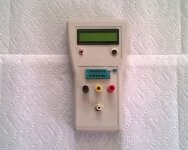
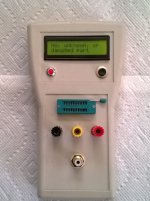
I then measured the capacitance of all RCA cables that I had in my possession.
I started with regular/generic RCA cables that came bundled with some of my DVD and CD players. All those cables have a length of 3-6 feet and their capacitance measured from 300 to 600 pF. The best generic cable had a capacitance of 328 pF per meter, which is too high for my tastes.
Generic RCA cable (328 pF per meter):
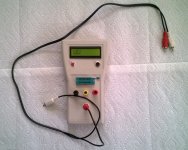
After that, I turned my attention to some of the premium cables that I had lying around. Surprisingly, the relatively cheap, Monoprice-branded cables were not worse (and sometimes even better) than much more expensive, premium RCA cables.
Monoprice 1.5ft Premium RCA 22AWG Cable (92 pF per meter) (1.5ft Premium 2 RCA Plug/2 RCA Plug M/M 22AWG Cable - Black - Monoprice.com):
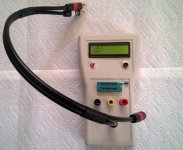
ATLONA Double Shielded Composite Video RCA Cable (78 pF per meter) (1M 3ft Atlona Composite Video RCA Cable TV DVD VCR Double Shielded Gold Plated | eBay):
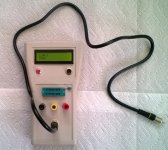
kenable Pure OFC HQ 2 x RCA Phono Plugs (256 pF per meter) (Amazon.com: kenable Pure OFC HQ 2 x RCA Phono Plugs to Plugs Stereo Audio Cable Gold 1m (~3 feet): Electronics):
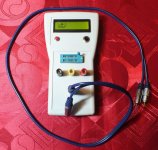
Acoustic Research Performance Series Component Video Cable (82 pF per meter) (Amazon.com: Acoustic Research Performance Series Component Video Cable: Computers & Accessories):
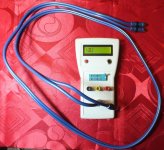
Unknown brand Component Video Cable (83 pF per meter):
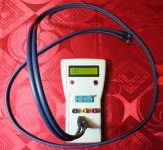
Finally, I measured the capacitance of a 1.5 feet RCA cable that I made myself out of Canare GS-6 guitar cable (Canare GS-6 Guitar Cable Per Foot - Black) and Rean RCA male plugs with gold contacts (Rean NYS373-0 RCA Male Plug with Gold Contacts - Black). Interestingly enough, although this DIY cable cost approximately $8 to make, it had a capacitance of over 140 pF per meter, thus failing to beat some of the cheaper cables in my possession.
DIY cable (147 pF per meter):
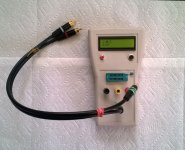
Please note, this post is for information purposes only. I am not urging anyone to purchase $1,000+ OFC gold-plated RCA cables with an ultra low capacitance. I made the measurements primarily for myself and then decided to share with the community.
Edit: There was a silly error in my Excel formula for converting feet to meters. The original post has been updated to show the correct values. I apologize for any inconvenience.
Here is the fixed table:

As a result, I got myself a device capable of measuring cable capacitance with an accuracy of up to 1 pF. The device can be seen on the pictures below:


I then measured the capacitance of all RCA cables that I had in my possession.
I started with regular/generic RCA cables that came bundled with some of my DVD and CD players. All those cables have a length of 3-6 feet and their capacitance measured from 300 to 600 pF. The best generic cable had a capacitance of 328 pF per meter, which is too high for my tastes.
Generic RCA cable (328 pF per meter):

After that, I turned my attention to some of the premium cables that I had lying around. Surprisingly, the relatively cheap, Monoprice-branded cables were not worse (and sometimes even better) than much more expensive, premium RCA cables.
Monoprice 1.5ft Premium RCA 22AWG Cable (92 pF per meter) (1.5ft Premium 2 RCA Plug/2 RCA Plug M/M 22AWG Cable - Black - Monoprice.com):

ATLONA Double Shielded Composite Video RCA Cable (78 pF per meter) (1M 3ft Atlona Composite Video RCA Cable TV DVD VCR Double Shielded Gold Plated | eBay):

kenable Pure OFC HQ 2 x RCA Phono Plugs (256 pF per meter) (Amazon.com: kenable Pure OFC HQ 2 x RCA Phono Plugs to Plugs Stereo Audio Cable Gold 1m (~3 feet): Electronics):

Acoustic Research Performance Series Component Video Cable (82 pF per meter) (Amazon.com: Acoustic Research Performance Series Component Video Cable: Computers & Accessories):

Unknown brand Component Video Cable (83 pF per meter):

Finally, I measured the capacitance of a 1.5 feet RCA cable that I made myself out of Canare GS-6 guitar cable (Canare GS-6 Guitar Cable Per Foot - Black) and Rean RCA male plugs with gold contacts (Rean NYS373-0 RCA Male Plug with Gold Contacts - Black). Interestingly enough, although this DIY cable cost approximately $8 to make, it had a capacitance of over 140 pF per meter, thus failing to beat some of the cheaper cables in my possession.
DIY cable (147 pF per meter):

Please note, this post is for information purposes only. I am not urging anyone to purchase $1,000+ OFC gold-plated RCA cables with an ultra low capacitance. I made the measurements primarily for myself and then decided to share with the community.
Edit: There was a silly error in my Excel formula for converting feet to meters. The original post has been updated to show the correct values. I apologize for any inconvenience.
Here is the fixed table:

Attachments
Last edited:
Video cable should have an RF characteristic impedance of 75ohms, and will normally have solid PVC dielectric giving a velocity factor of 0.66. It should therefore have a capacitance of 66pF/m. Either it isn't genuine video cable, or you have a measurement problem.TripathFan said:Unknown brand Component Video Cable (25 pF per meter):
The low capacitance of cheapo RCA cable may be a sign of very poor shielding.
If your signal source is high impedance, there will be HF loss. If, as most pre amp and line source equipment, the output impedance is 2k or less, there will be no appreciable losses using high capacitance cabling. Most line level is quoted at 600R.
3dB point for 2k and say 1200pF is 24kHZ, way above the human hearing spectrum. This is for unbalanced cabling.
3dB point for 2k and say 1200pF is 24kHZ, way above the human hearing spectrum. This is for unbalanced cabling.
Older cables types like RG59, KX7, etc had solid PE dielectric. Newer ones generally have foam PE dielectric and a much reduced capacitance.Video cable should have an RF characteristic impedance of 75ohms, and will normally have solid PVC dielectric giving a velocity factor of 0.66.
I have never seen (true) coaxial cables using PVC as a dielectric, only shielded cables.
Something like CT165, which is a good 75R satellite cable, manages 53pF/m, thanks to air spacing. Only 93R coax manages better, but it's hard to find.
Cables with lower capacitance are probably only partially shielded and not really coax
Cables with lower capacitance are probably only partially shielded and not really coax
Here are a few i measured before,
Belden 89259 .75m = 47pf
Cambridge Audio Silver Reference .75m = 52pf
Cambridge Audio Qunex 99% OFC .75m = 104pf
Multicore cables (i.e. non coax)
NavShips 2x24g dual core shielded silver plated 1m = 54pf
Canare L-2T2S dual core shielded 1m = 78pf
Van Damme XKE quad core shielded silver plated 1m = 88pf
Canare L-4E6S quad core shielded 1m = 160pf
Measurements were taken with a cheap ebay meter so i cant claim absolute accuracy, but as a point of reference the Belden 89259 specs are 17pF/Ft, which is 56.7pF/Meter so my measurement of 47pf for .75m means its in the right ball park.
Belden 89259 .75m = 47pf
Cambridge Audio Silver Reference .75m = 52pf
Cambridge Audio Qunex 99% OFC .75m = 104pf
Multicore cables (i.e. non coax)
NavShips 2x24g dual core shielded silver plated 1m = 54pf
Canare L-2T2S dual core shielded 1m = 78pf
Van Damme XKE quad core shielded silver plated 1m = 88pf
Canare L-4E6S quad core shielded 1m = 160pf
Measurements were taken with a cheap ebay meter so i cant claim absolute accuracy, but as a point of reference the Belden 89259 specs are 17pF/Ft, which is 56.7pF/Meter so my measurement of 47pf for .75m means its in the right ball park.
why not just read the Belden, Alpha catalogs, tech specs?
Whitlock pointed out that in consumer audio RCA interconnect shield resistance should be as low as possible
http://www.belden.com/techdatas/metric/8241F.pdf
Whitlock pointed out that in consumer audio RCA interconnect shield resistance should be as low as possible
audio return signal current isn't the only current in the unbalanced gnd/shield/return - chassis leakage, gnd loop current, some EMI
symmetry, 100% coverage, 360 degree shield-connector barrel termination all make differences - as commonly found in "video" RCA cable
Whitlock:
"Exotic cables will not stop noise. Expensive cables, even if double or triple shielded, made of 100% unobtainium, and hand woven by virgins will have no significant effect on hum or buzz. Only the resistance of the grounded conductor can make a difference.' If you have to use coax, Belden 8241F, with a low-resistance copper-braid shield, works well for audio and video.
from:
Washington June AES - SMPTE.org
http://www.belden.com/techdatas/metric/8241F.pdf
Electrical Characteristics (Overall)
Nom. Characteristic Impedance:
Impedance (Ohm)
75
Nom. Inductance:
Inductance (μH/m)
0.29529
Nom. Capacitance Conductor to Shield:
Capacitance (pF/m)
56.7613
Nominal Velocity of Propagation:
VP (%)
78
Nominal Delay:
Delay (ns/m)
4.2653
Nom. Conductor DC Resistance:
DCR @ 20°C (Ohm/km)
49.215
Nominal Outer Shield DC Resistance:
DCR @ 20°C (Ohm/km)
8.5306
Last edited:
Video cable should have an RF characteristic impedance of 75ohms, and will normally have solid PVC dielectric giving a velocity factor of 0.66. It should therefore have a capacitance of 66pF/m. Either it isn't genuine video cable, or you have a measurement problem.
I tested the device on a number of different capacitors with 1% tolerance and it always showed the correct capacitance. Consequently, there is no reason for me to believe that it produces incorrect results.
On the other hand, it is quite possible that both of my component video cables are not up to par specwise.
Here are a few i measured before,
Belden 89259 .75m = 47pf
Cambridge Audio Silver Reference .75m = 52pf
Cambridge Audio Qunex 99% OFC .75m = 104pf
Multicore cables (i.e. non coax)
NavShips 2x24g dual core shielded silver plated 1m = 54pf
Canare L-2T2S dual core shielded 1m = 78pf
Van Damme XKE quad core shielded silver plated 1m = 88pf
Canare L-4E6S quad core shielded 1m = 160pf
Measurements were taken with a cheap ebay meter so i cant claim absolute accuracy, but as a point of reference the Belden 89259 specs are 17pF/Ft, which is 56.7pF/Meter so my measurement of 47pf for .75m means its in the right ball park.
Those measurements look interesting. Thanks for sharing.
Yes, you are right. I don't know why I said PVC when I knew that RF coax usually used polyethylene.Elvee said:Older cables types like RG59, KX7, etc had solid PE dielectric.
Even air dielectric would be about 45pF/m. Anything less than this is not 75ohm cable.Newer ones generally have foam PE dielectric and a much reduced capacitance.
I notice that the figures in the first post have now changed! The 25pF cable is now 83pF.
Video cable should have an RF characteristic impedance of 75ohms, and will normally have solid PVC dielectric giving a velocity factor of 0.66. It should therefore have a capacitance of 66pF/m. Either it isn't genuine video cable, or you have a measurement problem.
The low capacitance of cheapo RCA cable may be a sign of very poor shielding.
You were right! There was a silly error in my Excel formula for converting feet to meters. The original post has been updated to show the correct values.
- Status
- Not open for further replies.
- Home
- Design & Build
- Parts
- Measuring the capacitance of some RCA cables
